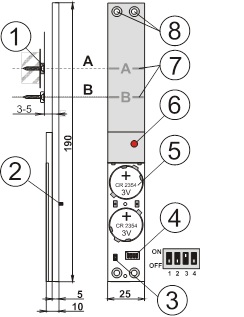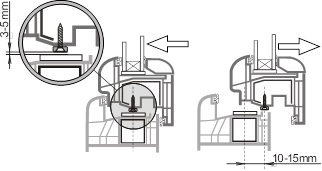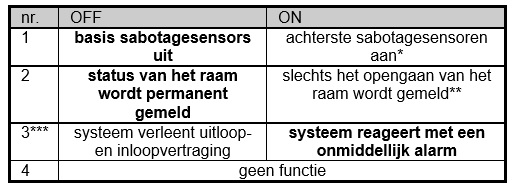JA-182M
Too much choice? Chat or call us at 085-0160316
There are no products in these categories. Shop on.

Service note for JA-182M
Wireless flush-mounted magnetic contact
This product is part of the Jablotron 100 series alarm system. It provides detection of the opening of a window (door). The detector is installed in plastic or wooden frames and can be used with most common types of hardware. The detector communicates wirelessly via the Jablotron protocol and is powered from batteries.
Installation of the detector - basic information
The installation must be done by a trained technician with valid Jablotron certification. The detector must not be bent or otherwise deformed - danger of damage.
The product is installed in the gap between the moving and fixed frame (where the locking mechanism of the hardware is).
In practice, different profiles of frames and different types of hardware exist. It is therefore advisable to check first whether the detector fits the type of window (or door) in question. If the profile of a wooden frame is narrower, a notch for fitting the detector can usually be milled out.
The detector is placed on the fixed frame, the activation magnet on the movable frame. The detector responds to the increase in distance of the magnet when the window opens. If the magnet supplied with the window version does not correspond accurately, either a suitable type of magnet can be requested from the window supplier, or the magnet supplied can be modified by using a suitable sole plate, etc.
Figure: 1. magnet; 2. rear tamper contacts; 3. screen tamper contact; 4. configuration switches; 5. battery; 6. LED signal light; 7. detection signs; 8.mounting holes
Mounting step by step
1. Find a suitable place to install the detector and magnet so that after closing the window, the magnet is above the A (or B) dash. By opening the window, the magnet should be removed by 2 cm min.
2. The best place is in the moving frame of the window, where there is no hardware (i.e. the detector should not be placed directly next to a metal). Such a place is usually found on the side between the hinges. Mounting the detector in the lower part of the window is not recommended, due to possible water condensation.
3. Screw the magnet against the moving frame according to the illustration. If the rebate in the window is wider than the plastic of the magnet, use a suitable non-metallic underlay under the magnet.
4. Unscrew the battery cover and mount the detector so that, when closed, the magnet is above the A or B line (see illustration). Carefully tighten the detector screws so as not to damage its plastic.
5. If the window frame or mounting location of the detector is not straight, put under the detector the supplied long plastic sole plates. With the detector installed, at least one rear tamper sensor must remain permanently depressed.
6. Carefully try to make sure the window closes and that the detector and magnet are not in the way.
7. If everything is OK, set the detector functions (see configuration switches)
8. In the central unit (receiver), switch on learning mode and then connect batteries to the detector and screw the cover on (2 screws). After connecting the batteries, the detector will send the learning signal. The detector will start responding to the magnification/reduction of the distance of the magnet and pressing/releasing of sabotage sensors only 10s after closing the cap of batteries.
9. After the detector learns, check its operation (on Jablotron central unit, also check signal quality).
10. Signal light - indicates detector activation for 15 minutes after closing the battery cover (window opening with flashing, activation of both rear sabotage sensors with long lighting up).
Configuration switches
Under the battery cover are 4 switches for detector setting:
Operation of the detector
With switch no.2 in position OFF, the detector reports that the window is permanently open. If the system is armed with a window open, the control unit bypasses the detector. However, if someone closes the window during arming and then opens it again (e.g. after sliding the window knob using a string in the open position), an alarm is triggered. If the keypad should not show that the window is permanently open, switch configuration switch no.2 in the ON position (only the opening of the window is reported).
Replace batteries in the detector
The system monitors the battery status and, as soon as they start to run low, informs the user (possibly also the service technician). The detector continues to work, but we recommend replacing the battery extremely within 2 weeks. Always replace both batteries with new ones at the same time and only use quality brand batteries (e.g. Panasonic). After replacing the batteries, it is recommended to test the detector's operation.
Do not dispose of used batteries with household waste, but dispose of them with chemical waste.
Take the detector out of the system
The system reports any loss of the detector. If you intentionally dismantle the detector, you must also delete it in the control centre.
Technical parameters
Power supply Lithium battery type CR2354- 2 pcs (3.0 V 1 Ah),
Source type C
Typical battery life approx. 3 years (max. 5 activations/day)
Communication band 868.1 MHz, protocol Jablotron
Communication range approx. 200m (direct visibility)
Dimensions 192 x 25 x 9 mm
Environments according to EN 50131-1 II. indoor, general
Range of operating temperatures -10 to +40 °C
Classification grade 2
compliant with EN 50131-1,EN 50131-2-6, EN 50131-5-3
Further complies with ETSI EN 300220, EN 50130-4,
EN 55022, EN 60950-1
JABLOTRON ALARMS a.s. hereby declares that the detector has been designed and manufactured in accordance with the provisions to be applied to it: Government Decree No. 426/2000 Sb., in the text of subsequently promulgated regulations, if used in accordance with its intended use.
Note: Although this product does not contain harmful materials, do not dispose of it in domestic waste, but dispose of it at the collection point intended for electronic waste.
